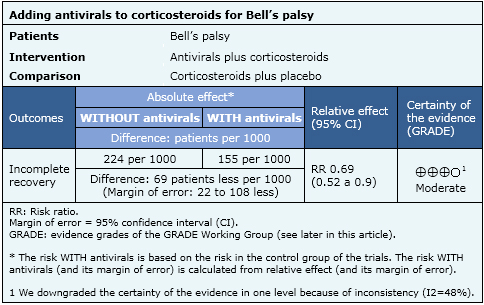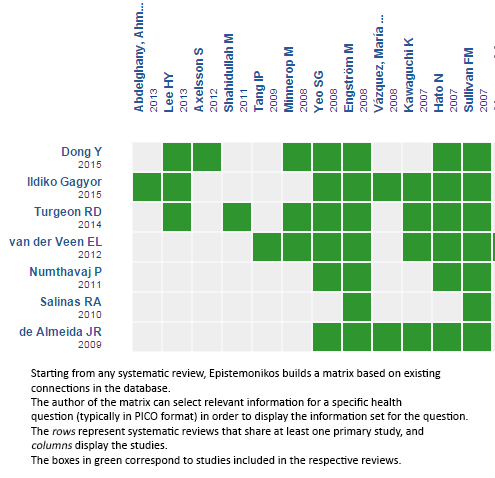Resúmenes Epistemonikos
← vista completaPublicado el 22 de agosto de 2015 | http://doi.org/10.5867/medwave.2015.6226
¿Es útil agregar antivirales a los corticoides en la parálisis de Bell en adultos?
Is there benefit adding antivirals to corticosteroids for Bell’s palsy in adults?
Abstract
Bell’s palsy is the first cause of unilateral facial palsy. The likely etiologic mechanism is facial nerve inflammation secondary to viral reactivation, most probably due to herpes simplex and Varicella Zoster. Corticosteroids are considered the mainstay of treatment, but it is not clear whether adding antivirals would further increase the benefit. Searching in Epistemonikos database, which is maintained by screening 30 databases, we identified 10 systematic reviews including 15 pertinent randomized controlled trials overall. We combined the evidence and generated a summary of findings following the GRADE approach. We concluded that adding antivirals to the treatment with corticosteroids probably reduces the risk of incomplete recovery in patients with Bell’s palsy.
Problem
Bell’s palsy consitutes the main cause of unilateral facial paralysis. Although most patients recover spontaneously, it leads to important limitations in some individuals. Herpes family reactivation by either herpes simplex or varicella zoster is accepted as the main etiology. It produces an inflammatory process that derives in edema of the perineural layer, myelin degeneration and inflammatory cells infiltration. It is not clear if adding antivirals, such as acyclovir and valacyclovir, to the standard treatment with corticosteroids would offer additional benefit.
Methods
We used Epistemonikos database, which is maintained by screening more than 30 databases, to identify systematic reviews and their included primary studies. With this information we generated a structured summary using a pre-established format, which includes key messages, a summary of the body of evidence (presented as an evidence matrix in Epistemonikos), meta-analysis of the total of studies, a summary of findings table following the GRADE approach and a table of other considerations for decision-making.
|
Key messages
|
About the body of evidence for this question
|
What is the evidence. |
We found 10 systematic reviews [1],[2],[3],[4],[5],[6],[7],[8],[9],[10] that consider 19 pertinent studies overall [11],[12],[13],[14],[15],[16],[17],[18],[19],[20],[21],[22], |
|
What types of patients were included |
All studies included adults with Bell’s Palsy diagnosed at different stages. Some studies did include patients based on severity according to House-Brackmann score. |
|
What types of interventions were included |
Seven studies included antiviral treatment using acyclovir [11],[12],[17],[18],[22],[24],[28], six valacyclovir [13],[14],[15],[16],[23],[26] and two famcyclovir [19],[21]. In five of the included studies antiviral treatment was added to prednisone [12],[15],[19],[23],[24], in nine to prednisolone [11],[14],[16],[17],[18],[21],[22],[26],[28], and in one to deflazacort [13]. All studies compared against corticosteroids monotherapy in the same dose than comparison group. |
|
What types of outcomes |
Main outcome: Long term complete recovery of facial mobility Other outcomes: reduction of recovery time in patients with severe palsy, short term complete mobility recovery, synkinesis, autonomic dysfunction and antiviral adverse effects |
Summary of findings
The information on the effects of adding antivirals to steroidal treatment for Bell’s palsy is based on 15 randomized studies including 2592 patients [11],[12],[13],[14],[15],[16],[17],[18],[19],[20],[21],[22],[23],[24],[25],[26],[27],[28]. All studies reported the outcome incomplete recovery.
- Adding antivirals to the treatment with corticosteroids probably reduces the risk of incomplete recovery in patients with Bell’s palsy. The certainty of the evidence is moderate.


Other considerations for decision-making
|
To whom this evidence does and does not apply |
|
| About the outcomes included in this summary |
|
| Balance between benefits and risks, and certainty of the evidence |
|
| Resource considerations |
|
|
Differences between this summary and other sources |
|
| Could this evidence change in the future? |
|
How we conducted this summary
Using automated and collaborative means, we compiled all the relevant evidence for the question of interest and we present it as a matrix of evidence.
 Full size
Full size Follow the link to access the interactive version: Antiviral agents added to corticosteroids versus corticosteroids alone for Bell's palsy in adults
Notes
The upper portion of the matrix of evidence will display a warning of “new evidence” if new systematic reviews are published after the publication of this summary. Even though the project considers the periodical update of these summaries, users are invited to comment in Medwave or to contact the authors through email if they find new evidence and the summary should be updated earlier. After creating an account in Epistemonikos, users will be able to save the matrixes and to receive automated notifications any time new evidence potentially relevant for the question appears.
The details about the methods used to produce these summaries are described here http://dx.doi.org/10.5867/medwave.2014.06.5997.
Epistemonikos foundation is a non-for-profit organization aiming to bring information closer to health decision-makers with technology. Its main development is Epistemonikos database (www.epistemonikos.org).
These summaries follow a rigorous process of internal peer review.
Conflicts of interest
The authors do not have relevant interests to declare.

